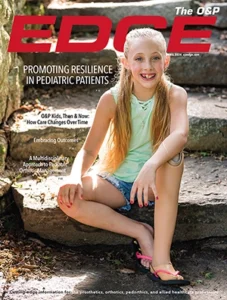The survey addressed several areas:
O&P & Allied Care
· More than 92 percent of the respondents use a prosthesis.
· Nearly 60 percent said they visit their prosthetist at least monthly, with over 68 percent seeing a physical therapist, and more than 66 percent meeting with an occupational therapist at least once per month.
· Seventy-eight percent of respondents believe the O&P industry could do more to support the emotional health of amputees, while nearly 66 percent believe O&P could do more to promote positive engagement in the community.
Amputation
· Nearly 8 percent had undergone their amputation within the past year, almost 35 percent had the amputation between one and three years ago, 22 percent between three and five years ago, over 15 percent were between five and 11 years, and 19 percent of the respondents had their amputation at least 11 years ago.
· The cause of the amputation for over 57 percent was trauma, 13 percent were congenital amputees, nearly 13 percent due to diabetes, and almost 12 percent underwent an amputation due to an infection.
· Almost 33 percent of the respondents were unilateral transtibial amputees, while over 16 percent had unilateral, Syme’s, bilateral transtibial, or unilateral transfemoral amputations.
· Regarding pain due to their amputation and what is used to treat it, 53.6 percent said they took medication, 39.3 percent use ice, 38.1 percent said they use massage, 19.9 percent use heat, 14.6 percent use compression, and 13.7 percent use a combination of relaxation, meditation, and mindfulness techniques.
Emotional Health
· More than 75 percent of those who responded said their emotional health was at least moderately affected immediately after the amputation, with over 73 percent saying they continue to at least sometimes experience issues with their emotional well-being.
· Seventy percent of those who completed the survey said they had a strong support system immediately following their amputation, and the same percentage indicate that strong support system remains.
Physical Activity
· Over 73 percent of those who completed the survey said they are active for at least 30 minutes each day, with 25 percent of that group specifying they are active more than 60 minutes per day. More than 29 percent said they participate in an adaptive sport or fitness program, while over 55 percent are interested in doing so.
Demographics
· More than 65 percent of the respondents were male.
· Nearly 70 percent were between the ages of 18 and 50.
· Nearly 70 percent had completed vocational training and/or obtained a bachelor’s degree.
· Over 55 percent were employed full-time or were active military.
· 13 percent worked part-time.
· Over 51 percent were married, and more than 30 percent were single.
· More than 60 percent were covered by Medicare (48.5 percent) or Medicaid (11.7 percent).
· Nearly 26 percent used private insurance.
Conditions Experienced
· Excessive sweat: 54.8 percent
· Phantom limb pain: 48.8 percent
· Skin irritation: 48.5 percent
· Residual limb pain: 46.1 percent
· Nerve pain: 44.4 percent
· Unwanted odor: 41.9 percent
· Dry skin: 39.6 percent
· Calluses: 32.1 percent
· Blisters: 31.6 percent
· Compensation injuries/pain: 29.8 percent
· Sores: 27.7 percent
· Infections: 22.3 percent
To see the complete survey, visit the TLW 2021 Amputee Community Survey Results.




